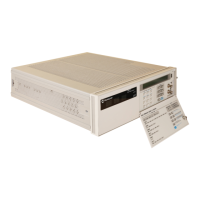2. Service
Diagnostic Trees and Procedures
34
5071A Diagnostic Tree Organization
Diagnostic-Tree Section 1 - Top-level Diagnostics Trees:
provides the beginning entry point for the troubleshooting process;
organized around start-up events, front-panel operation/messages, and
rear-panel output/input signals.
Diagnostic-Tree Section 2 - Functional-Group Diagnostic Trees:
provides diagnostic trees for any two or more assemblies or modules that
interact with each other in the normal performance of instrument
operation.
Diagnostic-Tree Section 3 - Assembly/Module Diagnostic Trees:
provides diagnostic trees for individual assemblies and modules when
indicated by either Top-level tree pointers or Functional-Group tree
pointers.
Navigating the Diagnostic Trouble-Tree
Sections
1 Go to the beginning of the Top-level diagnostic tree:
a) If you already know the symptom/operating problem - go to the
subsection in section 1 that provides its fault isolation.
b) If you do not know what's wrong with a failed instrument, start at
the beginning of the Top-level tree checking all items sequentially
until you find a specific isolated fault or find a pointer to further
details in sections 2 or 3.
2 If you know for certain
the general hardware area where the fault
exists, go to the applicable Functional-Group diagnostic tree in
section 2. (If replacement of an obviously defective component
does not restore normal operation, then you must start at step 1b
above).
3 If you know for certain
that a particular assembly/module is at
fault, go to section 3, Assembly/Module diagnostic trees to locate
the applicable diagnostic tree. (If replacement of an obviously
defective component does not restore normal operation, then you
must start at step 1b above.)

